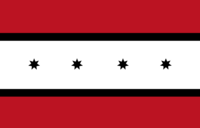Kagoria
Kagoria | |||||||||||
|---|---|---|---|---|---|---|---|---|---|---|---|
|
Flag of the Kagor tribe | |||||||||||
 | |||||||||||
| Capital | Psydo | ||||||||||
| Common languages | Kavardan (official) Aramaic (official) | ||||||||||
| Religion | Habzism Judaism Pytabian Christianity | ||||||||||
| Government | Monarchy | ||||||||||
| History | |||||||||||
• Kagorians gain control of Kavarda | 350 | ||||||||||
• Zuhraid Caliphate conquers Kagoria | 709 | ||||||||||
| |||||||||||
Kagoria was a Kavardan empire in western Terranihil established by the semi-nomadic Kagor tribe in the 4th century CE. The ruling elite of the Kagorians had converted to Judaism in the 6th century. The majority of Kavardans practiced their native religion of Habzism. The empire conquered surrounding regions including Alaia in 600. Kagoria fought for control of Alaia with the Romanyan Empire and then the Mutadinun Caliphate. The Mutadinun conquered Alaia in 650 and Kagoria shrunk to only control Kavarda. Then in 709, the Zuhraid Caliphate conquered Kavarda.
Etymology
Kagoria is a Romanyanization of the Kavardan khagurikwe (Old Kavardan: 𐏂𐎦𐎼𐎤𐎠), the name of the founding tribe of Kagoria. Khagurikwe means "traveler". The name Kagor for this tribe was then derived from the word Kagoria.
History
The Kagor tribe was a semi-nomadic Kavardan tribe. They control lands north of Psydo during the Kavardan Warring States period. In 325, the Kagor tribe conquered Psydo and then captured the rest of Kavarda by the 5th century. Kagoria focused on internal projects including improving roads and establishing a single currency.
In 410, the Pytabian Church of the West established itself in eastern Kagoria in Mestaga. The Kagorians were tolerant of other religions and allowed the spread of Christianity. The Romanyan persecution of Jews led to the influx of Aramaic-speaking Jews into Kagoria. In the 6th century, the ruling elites of Kagoria converted to Judaism.
The Romanyan Empire launched an unsuccessful invasion of Kagoria in the 530s. In 593, Kagoria invaded Romanyan Alaia. The Pytabian Christians of the Western rite supported the invasion. Those of the Eastern rite were divided, as they were discontent with the Romanyan exile of miaphysite church leaders but also wary of impositions by the Church of the West. The Jews of Alaia generally supported the Kagorian invasion. Kagoria conquered Alaia by 600. The Kagorian rulers portrayed themselves as restoring the tradition of the Tundrens who had preceded them in conquering Alaia.
By the mid 7th century, the Mutadinun Caliphate had conquered much of the eastern territories of the Romanyan Empire and was then the southern neighbor of Kagoria. The Mutadinun invaded Alaia in 645 and conquered it by 650. The Kagorians were forced to retreat to Kavarda but were successful in defending Kavarda against the Mutadinun.
In 664, the Zuhraid dynasty overthrew Aiman, the last Mutadinun Caliph, and established the Zuhraid Caliphate. It invaded Kagoria in 695 and conquered its capital of Psydo in 709.
Language
The people of Kavarda spoke their native language of Kavardan. Aramaic was also spoken by some including the wealthy as the language had spread to Kavarda during the Tundren Empire. After the conquest of Alaia, Aramaic was used as the lingua franca of the empire. The Kagorian elites also spoke it because of the Aramaic Jewish tradition.
Religion
Most Kavardans under the Kagorian Empire practiced Habzism, their native pagan religion. The Kagorian elites however converted to Judaism in the 6th century. Pytabian Arameans established the Pytabian Church of the West in the Kagorian city of Mestaga in 410. The Christian Aramean population in Kagoria grew significantly. The ruling Kavardan Jews were tolerant of other religions in their Empire, allowing the construction of churches.
Architecture
- Photo gallery





